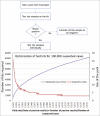The 2019-2020 Novel Coronavirus (Severe Acute Respiratory Syndrome Coronavirus 2) Pandemic: A Joint American College of Academic International Medicine-World Academic Council of Emergency Medicine Multidisciplinary COVID-19 Working Group Consensus Paper
- PMID: 32773996
- PMCID: PMC7384689
- DOI: 10.4103/jgid.jgid_86_20
The 2019-2020 Novel Coronavirus (Severe Acute Respiratory Syndrome Coronavirus 2) Pandemic: A Joint American College of Academic International Medicine-World Academic Council of Emergency Medicine Multidisciplinary COVID-19 Working Group Consensus Paper
Abstract
What started as a cluster of patients with a mysterious respiratory illness in Wuhan, China, in December 2019, was later determined to be coronavirus disease 2019 (COVID-19). The pathogen severe acute respiratory syndrome coronavirus 2 (SARS-CoV-2), a novel Betacoronavirus, was subsequently isolated as the causative agent. SARS-CoV-2 is transmitted by respiratory droplets and fomites and presents clinically with fever, fatigue, myalgias, conjunctivitis, anosmia, dysgeusia, sore throat, nasal congestion, cough, dyspnea, nausea, vomiting, and/or diarrhea. In most critical cases, symptoms can escalate into acute respiratory distress syndrome accompanied by a runaway inflammatory cytokine response and multiorgan failure. As of this article's publication date, COVID-19 has spread to approximately 200 countries and territories, with over 4.3 million infections and more than 290,000 deaths as it has escalated into a global pandemic. Public health concerns mount as the situation evolves with an increasing number of infection hotspots around the globe. New information about the virus is emerging just as rapidly. This has led to the prompt development of clinical patient risk stratification tools to aid in determining the need for testing, isolation, monitoring, ventilator support, and disposition. COVID-19 spread is rapid, including imported cases in travelers, cases among close contacts of known infected individuals, and community-acquired cases without a readily identifiable source of infection. Critical shortages of personal protective equipment and ventilators are compounding the stress on overburdened healthcare systems. The continued challenges of social distancing, containment, isolation, and surge capacity in already stressed hospitals, clinics, and emergency departments have led to a swell in technologically-assisted care delivery strategies, such as telemedicine and web-based triage. As the race to develop an effective vaccine intensifies, several clinical trials of antivirals and immune modulators are underway, though no reliable COVID-19-specific therapeutics (inclusive of some potentially effective single and multi-drug regimens) have been identified as of yet. With many nations and regions declaring a state of emergency, unprecedented quarantine, social distancing, and border closing efforts are underway. Implementation of social and physical isolation measures has caused sudden and profound economic hardship, with marked decreases in global trade and local small business activity alike, and full ramifications likely yet to be felt. Current state-of-science, mitigation strategies, possible therapies, ethical considerations for healthcare workers and policymakers, as well as lessons learned for this evolving global threat and the eventual return to a "new normal" are discussed in this article.
Keywords: 2019-nCoV; COVID-19; International Health Security; coronavirus; global impact; pandemic; severe acute respiratory syndrome coronavirus 2.
Copyright: © 2020 Journal of Global Infectious Diseases.
Conflict of interest statement
There are no conflicts of interest.
Figures









References
-
- Kaewunruen S, Sussman JM, Matsumoto A. Grand challenges in transportation and transit systems. Frontiers Built Environ. 2016;2:4.
-
- Rodrigue JP. Globalization and the synchronization of transport terminals. J Transport Geography. 1999;7:255–61.
-
- Kulmala I. Tackling the spread of pathogens in transport hubs. Drug Target Rev. 2016;3:46–9.
LinkOut - more resources
Full Text Sources
Other Literature Sources
Medical
Research Materials
Miscellaneous
